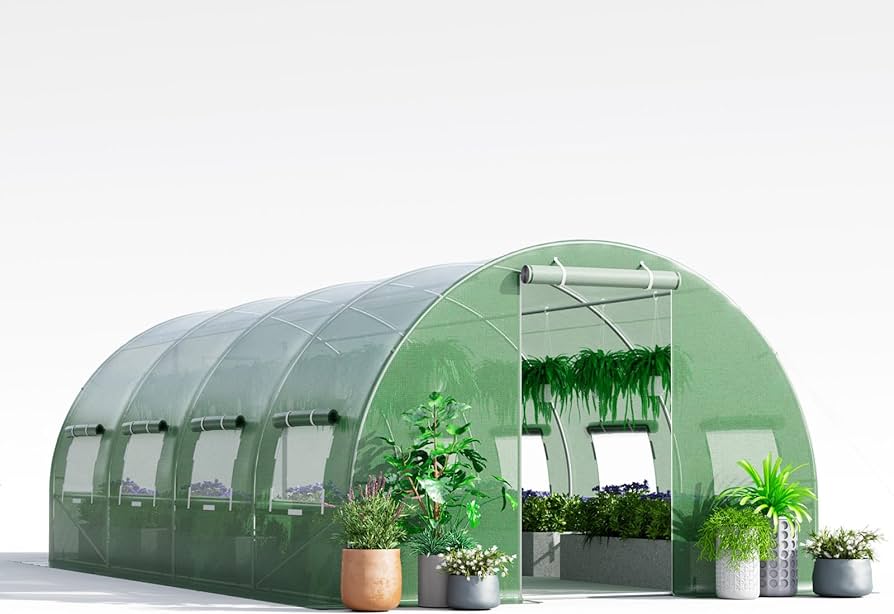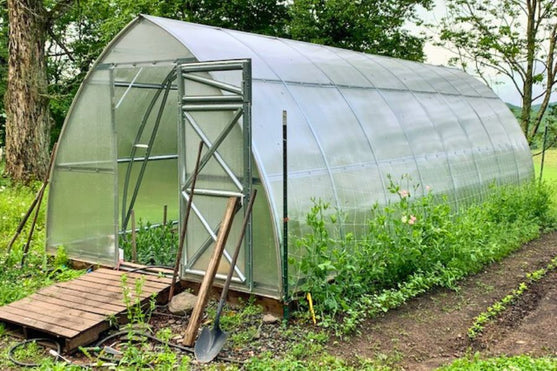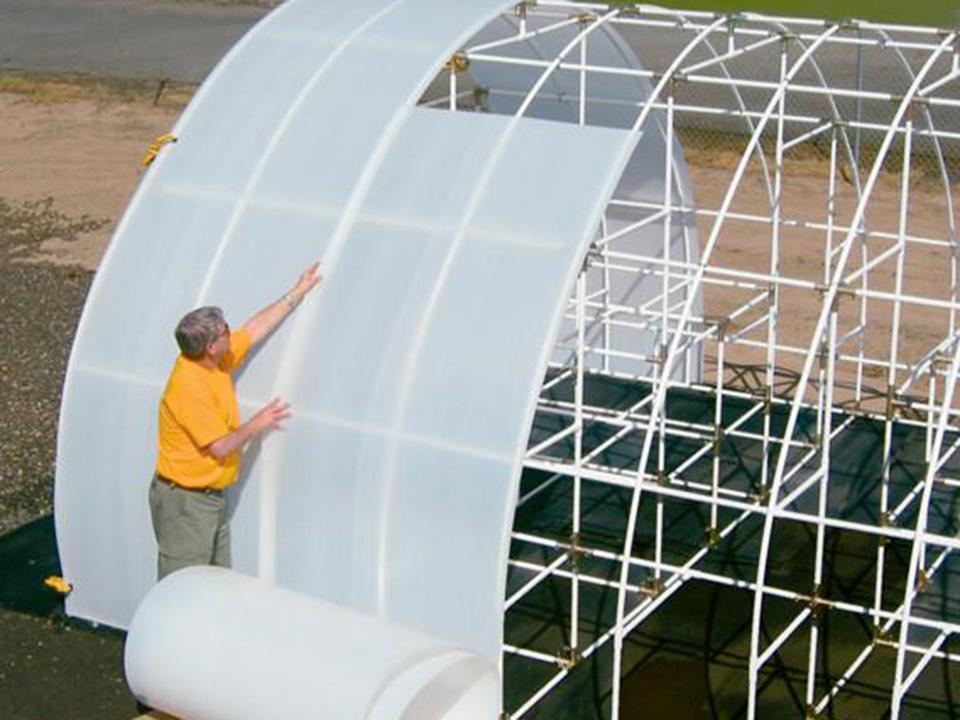Key Takeaways
- Heavy duty greenhouse kits are essential for gardens in windy areas, providing protection and stability for plants.
- Look for greenhouses with sturdy frames, typically made of galvanized steel or aluminum, and polycarbonate panels for wind resistance.
- Consider the size, design, and materials of the greenhouse kit to ensure it meets your gardening needs and withstands weather challenges.
- Anchor your greenhouse properly to prevent damage from high winds, and perform regular maintenance for longevity.
- Investing in a quality heavy-duty greenhouse kit can extend your growing season and protect your gardening investments.
Wind-Proof Your Garden with Top Greenhouse Kits
As a gardening enthusiast, you know the joy of nurturing plants through the seasons. But when the winds pick up, that joy can quickly turn into worry. To shield your tender greens from the harsh elements, a heavy-duty greenhouse is not just a luxury—it’s a necessity. Let’s dive into why these robust structures are the guardians of your garden and how they can transform your gardening experience.
Why Sturdiness Matters
Why should you care about a greenhouse’s sturdiness? The answer is simple: protection and peace of mind. A sturdy greenhouse stands as a barrier between your plants and the unpredictable weather, especially high winds that can wreak havoc on delicate seedlings and disrupt the nurturing environment your plants need to thrive.
Moreover, a heavy-duty build means longevity. It’s an investment that pays off, season after season, by withstanding the test of time and weather. In short, sturdiness equals reliability, and that’s exactly what you need for a resilient garden.
Key Features of High Winds Resistant Greenhouses
Now, let’s talk about what makes a greenhouse capable of standing up to gusty challenges. There are a few key features you should look for:
- Robust Frame: A frame made from galvanized steel or heavy-duty aluminum is non-negotiable. It’s the skeleton that holds everything together.
- Polycarbonate Panels: These are your best bet for wind resistance. They’re tough, transparent, and much safer than glass.
- Secure Anchoring: A greenhouse that isn’t anchored properly might as well be a giant kite. Make sure the kit includes a solid anchoring system.
- Wind Rating: Check the product specifications for wind resistance ratings. The higher the rating, the better it will stand up to gusty conditions.
Remember, your greenhouse should be a fortress for your plants, keeping them safe from the storms outside.
Heavy-Duty Greenhouse Kits: An Overview
Let’s get into the nitty-gritty of what a heavy-duty greenhouse kit entails. These kits come with everything you need to set up a resilient structure in your backyard. They’re designed for gardeners who mean business when it comes to protecting their green thumb achievements.
But don’t be daunted by the term ‘heavy-duty.’ It doesn’t mean you’ll be wrestling with unwieldy parts. Modern kits are user-friendly, with clear instructions and manageable components. What they offer is enhanced durability and strength, thanks to the materials and design tailored for high-wind scenarios.
Understanding the Framework
The framework of your greenhouse is like the foundation of a house. It needs to be strong, because everything else rests upon it. For heavy-duty kits, the frame is typically made of galvanized steel or aluminum. These materials are not just tough; they’re also resistant to rust and corrosion, which means they’ll last through many seasons of damp, windy weather.

“Heavy Duty Galvanized Steel Frame …” from www.amazon.com
And let’s talk about the design. A good frame is not only about the material; it’s also about the construction. Look for frames with reinforced joints and crossbars. These are the spots that will face the most stress during windy conditions, so they need to be extra sturdy.
Essential Materials for Durability
Besides the frame, the materials used for the walls and roof of the greenhouse are vital. Polycarbonate panels are the go-to choice for heavy-duty kits. They’re virtually unbreakable, provide excellent insulation, and let in the sunshine your plants crave. Plus, they’re lighter than glass, making them easier to handle and install.
Some kits come with twin-wall polycarbonate panels, which consist of two layers with an air space in between. This design not only adds to the wind resistance but also improves insulation, keeping your greenhouse warmer in winter and cooler in summer.
When you’re selecting your greenhouse kit, pay attention to the thickness of the panels. Thicker panels mean better insulation and increased sturdiness. And while you’re at it, make sure the panels have UV protection to prevent them from yellowing over time.
Investing in the Right Kit
Choosing the right heavy-duty greenhouse kit is a crucial decision for any gardener. It’s about more than just buying a product; it’s about investing in the future of your garden. So, take your time, do your research, and consider the following factors before making your purchase.
Factors to Consider Before Purchase
- Size: How much space do you have in your yard, and how much space do your plants need? Make sure the greenhouse will fit comfortably in your space and provide enough room for your gardening ambitions.
- Design: Do you want a traditional peak-roofed greenhouse, or is a lean-to design that attaches to your house more your style? The design affects not just aesthetics but also functionality and wind resistance.
- Materials: We’ve talked about steel and polycarbonate, but make sure the specifics match your needs. Check the gauge of the steel and the thickness of the panels.
- Assembly: Consider how much time and effort you’re willing to put into assembling your greenhouse. Look for kits that balance ease of assembly with sturdiness.
- Warranty: A good warranty is a sign that the manufacturer stands behind their product. It gives you peace of mind knowing that your investment is protected.
Remember, the goal is to find a greenhouse that will stand firm against the wind, rain, and whatever else nature throws your way.
Best Practices for Selecting a Kit
When you’re on the hunt for the perfect heavy-duty greenhouse kit, keep these best practices in mind:
- Read reviews from other gardeners who have faced similar weather conditions. Their experiences can provide invaluable insight.
- Consult with local gardening groups or experts. They can offer advice tailored to your area’s climate and conditions.
- Don’t compromise on quality for the sake of price. The cheapest option might end up costing more in the long run if it can’t withstand the weather.
By following these tips, you’ll be well on your way to finding a greenhouse kit that can handle the winds and become a centerpiece of your garden for years to come.
Choosing the right greenhouse kit is like picking a shield for your garden – it has to be robust enough to protect your green sanctuary. With so many options out there, it can be overwhelming to decide which one will best suit your needs. To help you out, I’ve narrowed down some top picks that are renowned for their resilience in the face of strong winds and harsh weather.
Top Picks for Wind-Resistant Greenhouse Kits
Sungrow 26 Backyard Greenhouse: Known for its sturdy design, the Sungrow 26 can withstand winds up to 65 mph. It’s a fortress for your plants.

“Sungrow 26 Backyard Greenhouse Kits.” from plantagreenhouses.com
Riverstone Industries Mont Greenhouse Series: With 8mm twin-wall polycarbonate panels, this series promises durability and excellent insulation.
Solexx Greenhouse Kits: Offering upgraded panels for enhanced light diffusion and insulation, Solexx kits are ideal for high-wind areas.
Each of these kits brings something unique to the table, but they all share one thing in common: they’re built to last. They have been designed with high winds in mind, so you can rest easy knowing your plants are safe.
But owning a heavy-duty greenhouse kit is just the beginning. Proper setup and maintenance are key to ensuring your greenhouse stands strong year after year.
Sungrow 26 Backyard Greenhouse
The Sungrow 26 Backyard Greenhouse is a top contender for those who need a resilient structure. Its galvanized steel frame is built to endure, while the polycarbonate panels keep your plants cozy. Easy to assemble and with a generous amount of space, this greenhouse is a haven for a wide variety of plants.
Riverstone Industries Mont Greenhouse Series
If you’re looking for something that can take on the elements, the Riverstone Industries Mont Greenhouse Series is your ally. With its 8mm polycarbonate panels, it’s like a suit of armor for your garden. This series also boasts a heavy-duty aluminum frame that ensures your greenhouse won’t budge, even when the winds are howling.
Solexx Greenhouse Kits with Upgraded Panels
For those who prioritize insulation and light diffusion, Solexx Greenhouse Kits are a dream come true. The upgraded panels offer superior heat retention, which is crucial for extending your growing season. This makes Solexx an excellent choice for gardeners who live in cooler climates or those who want to get a head start on spring planting.
Setting Up Your Greenhouse
Once you’ve picked out your heavy-duty greenhouse kit, it’s time to set it up. The right foundation is crucial, especially in windy areas. You’ll want to choose a spot that’s relatively sheltered from the wind, if possible. Level ground is a must, and you should consider a solid base like concrete or heavy pavers to keep your greenhouse anchored.
Assembling your greenhouse might seem daunting, but with a little patience and some basic tools, you can create a secure home for your plants. Always follow the manufacturer’s instructions closely, and if you’re not confident in your DIY skills, don’t hesitate to enlist the help of a friend or a professional.
Anchor It Right
Anchoring your greenhouse properly is one of the most critical steps you can take to ensure its stability. Most heavy-duty kits come with anchoring systems designed for this purpose. Whether it’s ground stakes, anchor bolts, or a weighted base, make sure to secure your greenhouse to the ground firmly.
It’s also a good idea to check the anchoring system periodically, especially after a big storm, to ensure everything is still tight and secure. A little maintenance can go a long way in preserving the life of your greenhouse.
Tips for Long-Term Maintenance
Maintenance is the key to longevity. Here are some tips to keep your greenhouse in top condition: For more detailed guidance, consider exploring best greenhouse kits which can provide insights into cold-weather solutions that may affect maintenance requirements.
- Regularly inspect your greenhouse for any signs of wear and tear, especially after extreme weather events.
- Clean the polycarbonate panels with a mild soap solution to maintain their clarity and light transmission.
- Check the frame for any rust or damage, and apply touch-up paint if necessary to prevent further corrosion.
- Make sure all doors, vents, and windows are operating smoothly and replace any worn seals or gaskets.
By taking these steps, you’ll ensure that your greenhouse remains a sturdy, safe, and welcoming environment for your plants for many years to come.
Gazebo-Style Greenhouses: A Unique Twist
Gazebo-style greenhouses are a charming addition to any garden. They’re not just functional; they also add a touch of elegance. With their unique design, they can withstand wind by distributing it evenly around the structure, reducing the risk of damage.

“Wrought Iron Outdoor Gazebo” from www.cnstatue.com
Features of Gazebo-Shaped Greenhouses
What sets gazebo-style greenhouses apart is their octagonal shape, which isn’t just for show. This design helps to deflect wind, making them exceptionally wind-resistant. They often come with sturdy frames and reinforced roofs, ensuring that your plants are protected from the elements.
Adapting to Different Garden Styles
One of the best things about gazebo-style greenhouses is their versatility. They can blend seamlessly into a variety of garden styles, from classic to contemporary. Whether you’re looking to create a focal point in your garden or a cozy nook for your plants, a gazebo-style greenhouse could be the perfect solution.
Walk-In Greenhouse Kits for Your Garden
For those who prefer a more traditional approach, walk-in greenhouse kits are a fantastic option. They offer ample space for you to move around, tend to your plants, and even include shelving and staging areas for maximum efficiency.
The Outsunny Polycarbonate Greenhouse
The Outsunny Polycarbonate Greenhouse is a standout in this category. It offers a spacious interior and a sturdy frame that can handle the elements. Plus, the clear polycarbonate panels ensure that your plants get plenty of light while staying protected.
With its easy-to-follow instructions and user-friendly design, the Outsunny Greenhouse is a solid choice for gardeners of all skill levels. It’s a place where you can nurture your plants and your passion for gardening, no matter the weather outside.
Benefits of Walk-In Structures
Walk-in greenhouses have several benefits that make them a popular choice, including their ability to maintain optimal airflow and CO2 levels for better plant growth.
- They provide plenty of headroom and space for both plants and gardeners.
- Shelves and staging areas allow for organized plant care and storage.
- The ability to walk inside means you can garden comfortably in all weather conditions.
Ultimately, the best greenhouse for you is one that fits your specific needs, whether that’s withstanding high winds, maximizing space, or enhancing the beauty of your garden. By choosing a heavy-duty greenhouse kit, you’re investing in the future of your gardening endeavors and ensuring that your green thumb continues to flourish, come rain or shine.
Choosing the right greenhouse kit is like picking a shield for your garden – it has to be robust enough to protect your green sanctuary. With so many options out there, it can be overwhelming to decide which one will best suit your needs. To help you out, I’ve narrowed down some top picks that are renowned for their resilience in the face of strong winds and harsh weather.

“Solexx Greenhouse Covering Rolls …” from greenhouseemporium.com
The Best Investments for Seasoned Gardeners
Seasoned gardeners understand the value of a reliable greenhouse. It’s not just about extending the growing season; it’s about creating a controlled environment where plants can prosper. Heavy-duty greenhouse kits are a wise investment for those who are serious about their horticultural pursuits.
Advance Your Gardening with Harvester Greenhouses
Harvester greenhouses are a top-tier choice for the committed gardener. They combine the sturdiness of heavy-duty construction with the practicality of a walk-in design. These greenhouses are designed to maximize space, with options for shelving and hydroponic setups, making them a versatile choice for any gardening project.
Why Professional-Grade Matters
When it comes to greenhouses, professional-grade materials and construction make a significant difference. They offer superior durability and resistance to weather, pests, and disease. Investing in a professional-grade greenhouse kit means investing in the health and productivity of your garden for the long haul.
Frequently Asked Questions on Heavy Duty Greenhouse Kits
Can Greenhouse Kits Stand Up to Tropical Storms?
Many heavy-duty greenhouse kits are designed to withstand high winds, but it’s essential to check the manufacturer’s specifications for exact wind ratings. While they can handle strong winds, tropical storms present extreme conditions that may require additional reinforcement or specific design features.
How Do I Calculate the Right Size for My Greenhouse?
To determine the right size for your greenhouse, consider the types of plants you want to grow, the space they require at maturity, and your overall gardening goals. Make sure to leave enough room for pathways and workspace. A good rule of thumb is to add an extra 25% to your initial space estimate to allow for future growth.
Are Polycarbonate Panels Better Than Glass in Windy Areas?
Polycarbonate panels are often preferred in windy areas because they are much more impact-resistant than glass and less likely to shatter. They also provide good insulation and light diffusion, which can be beneficial for plant growth.
Is It Necessary to Have a Foundation for My Greenhouse?
A solid foundation is not always necessary, but it can provide stability and level ground for your greenhouse. In windy areas, a foundation can help anchor the structure and prevent it from shifting or toppling over. For more detailed information, you can read about A-frame greenhouse construction which includes foundational considerations.
